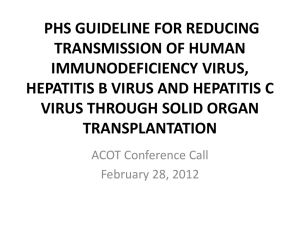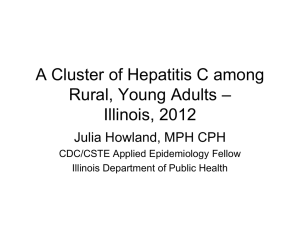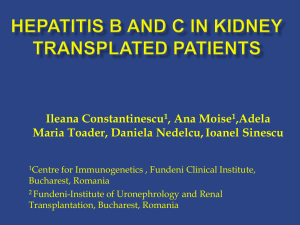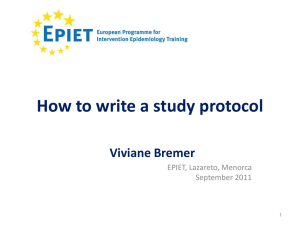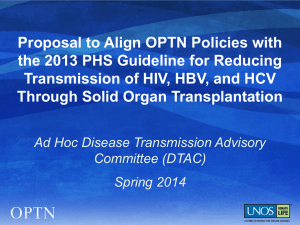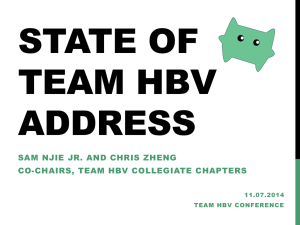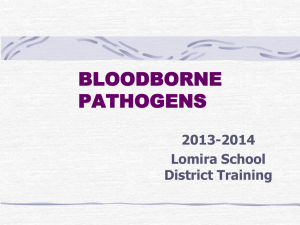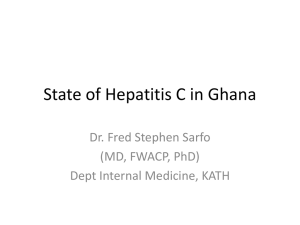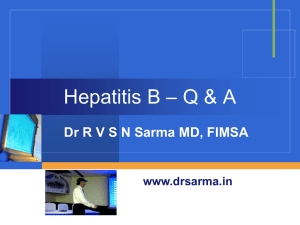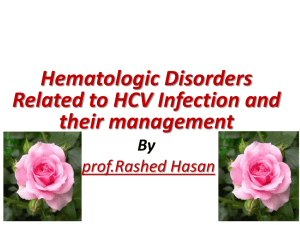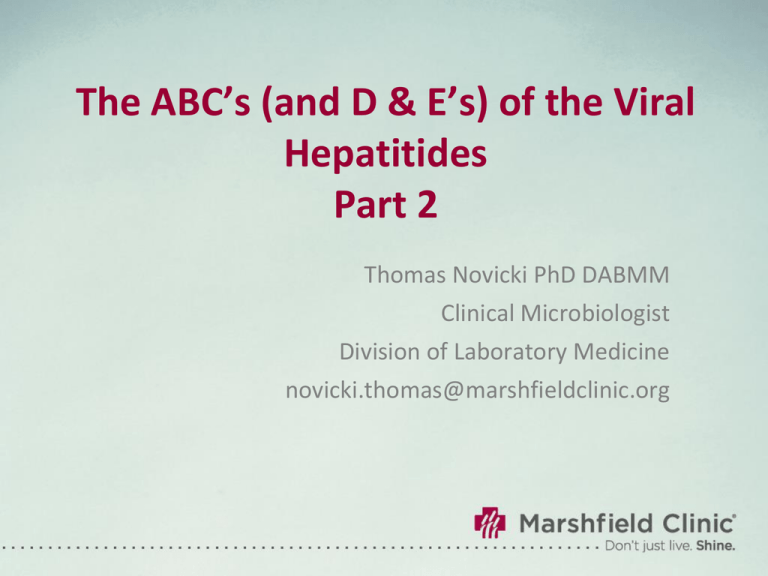
The ABC’s (and D & E’s) of the Viral
Hepatitides
Part 2
Thomas Novicki PhD DABMM
Clinical Microbiologist
Division of Laboratory Medicine
novicki.thomas@marshfieldclinic.org
Objectives 2
1. Explain the various modes of transmission of
2.
3.
4.
5.
each virus discussed.
Describe the mortality and morbidity associated
with the viral hepatitides.
Give a basic description of the makeup and
structure of each virus.
Be able to select the correct lab diagnostics for
each virus discussed.
Discuss current treatments and efficacy.
Disclosures 3
I have nothing relevant to this topic to
disclose.
All tables and graphs have been drawn from
public domain websites.
4
DIAGNOSTIC TESTS
Review of Acute Antigen (Ag)/Antibody (Ab) Responses
Convalescence
Acute (symptomatic)
Intensity
Viable virions
Free Ag
IgM
IgG
Ag/Ab complex
Cx
Serology
Ag detection
Molecular Dx
Time
?
5
Ag/Ab Relationships in Chronic Infection
These patterns apply to acute viral hepatitis
(VH) infections, but change in chronic VH:
Viral antigen and virions (i.e. viral particles) usually
remain detectable in blood and other fluids.
IgG class Abs directed against the virus do not
appear as expected.
These differences present many
diagnostic opportunities.
6
Blood Studies for Suspected VH
Alanine and aspartate amino transferases
Total and Direct bilirubin
Albumin and total protein
CBC
aPTT, PT/INR
Alpha fetoprotein
HAV,HBV,HCV Ab/Ags (more in a moment…)
7
HAV & HEV 8
Diagnosis of HAV and HEV is less complex
than the others, due to no chronic phase.
The primary markers measured are virusspecific antibodies.
However, the lack of an IVD assay for HEV
antibody hampers testing in the USA.
HAV
HAV & HEV Abs
9
HEV similar,
EXCEPT that IgG
anti-HEV falls off
rapidly after 6-12
months, and may
not confer
immunity for life.
HAV Diagnosis
10
IgM detection is required for diagnosis; many
commercial assays are available.
Total/IgG anti-HAV assays assess immune status
only, since IgG anti-HAV persists for decades.
While a positive result indicates immunity, commercial
assays don’t reliably detect vaccine-induced immunity.
Antigen detection and nucleic acid amplification
tests (NAAT) are not commercially available, and
HAV is not cultivable.
HEV Diagnosis
11
IVD assays not available. At least one
commercial reference lab and the CDC offers
anti-HEV antibody testing: IgM detection is
the key to diagnosis.
CDC also performs RT-PCR and genotyping.
Virus is not cultivable.
Best approach? Contact the WI DPH or WSLH
if HEV is suspected.
HBV/HDV Diagnosis
12
The diagnosis of HBV & HDV is more complex
due to acute and chronic phases of infection.
Diagnosis initially made by detection of viral Ag &
Ab.
Staging and monitoring therapy also uses
quantitative nucleic acid amplification testing
(NAAT; i.e. ‘viral load’).
In contrast to HCV, HBV genotyping is not
routinely done to begin therapy.
HBV Ag/Ab Detection: The Players
Ag/Ab
Hepatitis B surface antigen
Hepatitis B core antigen
Hepatitis B e antigen
Abbreviation
HBsAg
Not detectable
HBeAg
Anti-HBsAg antibody (Total)
Anti-HBs
Anti-HBcAg antibody (IgM &Total)
Anti-HBc
Anti-HBeAg antibody (Total)
Anti-HBe
13
Serology of HBV Acute and Chronic Infection
Acute
Chronic
http://publichealthlab.ca/wp-content/uploads/2012/10/GTS-Anti-HBs-Chart-1.jpg
http://www.cdc.gov/immigrantrefugeehealth/guidelines/domestic/viral-hepatitis-figure4.html
(accessed 02/27/2013)
14
HBV Serological Tests
15
Primary Markers
HBsAg Indicates ongoing infection, acute or chronic.
OR
Anti-HBs Indicates resolved infection. Alone, a marker of vaccination (>
10mIU/mL considered protective).
IgM anti-HBc Indicates acute infection.
REPLACED BY
Total anti-HBc Denotes evolved infection; does not differentiate chronic vs.
resolved infection.
Secondary Markers
HBeAg Indicates rapid viral replication, high infectivity.
REPLACED BY
Anti-Hbe Seen in resolved acute & inactive chronic infection.
Chronic HBV Markers: A Closer Look 16
Phase (Stage)
Immune Tolerance
Positive Lab Findings
HBsAg, Total anti-HBc, HBeAg, HBV DNA
Immune Clearance HBsAg, Total anti-HBc, HBeAg, HBV DNA, transaminases,
abnormal liver histology
Inactive CS
(Occult hepatitis B)
HBsAg, Total anti-HBc, anti-HBe, (Transaminases may flare)
+ findings for Total anti-HBc, transaminases, abnormal liver
histology. HBV DNA detectable only by sensitive research assays
Isolated Anti-HBc – Negative for both HBsAg & anti-HBs is not unusual (0.5-20%);
Positive
meaning unclear. Needs follow-up; may be infectious.
CS, HBsAg Carrier State; HBV DNA, > 20,000IU/mL
Horvat, RT and GE Tegtmeier 2011. Hepatitis B and D Viruses, p 1670-71. In J. Versalovic et al (eds), Manual of
Clinical Microbiology, 10th ed. ASM Press, Washington DC & A Valsamakis 2007 Clin Microbiol Rev 20:426
HBV NAAT
17
Quantitative NAAT
Several commercially available assays
A WHO HBV international standard exists.
However, quantitation still varies among assays.
Best practice is to consistently use the same assay.
If changing a viral load assay, perform and report both
assays (only charging for one) for 3-6mos to ‘reset’ all
patient’s viral loads as a service to your providers.
HBV NAAT
18
Some HBV Viral Load Interpretive Guidelines
>1log10 (i.e. >10-fold) reduction is predictive of
therapeutic success, while >1log10 increase during
treatment suggests development of antiviral resistance.
Increasing levels correlate histologically with cirrhosis.
Sustained suppression of viral DNA is the best measure
of long term therapeutic success.
Horvat, RT and GE Tegtmeier 2011. Hepatitis B and D Viruses, p 1671. In J. Versalovic et al
(eds), Manual of Clinical Microbiology, 10th ed. ASM Press, Washington DC
HDV Diagnosis
19
HBV co-infection required-also test for HBV.
Anti-HDV Ab detection
Screen with Total anti-HDV
Reflex to IgM anti-HDV to assess for acute state
Viral load testing for disease activity
But, there are no FDA cleared IVD assays.
HCV Diagnosis-Some Differences…
20
Acute infection usually asymptomatic, so most cases
appear after years of silent chronic infection.
Unlike HBV, HCV genotype or level of viremia do not
correlate with severity or likelihood of chronic disease
progression. However genotype and viral loads are
critical in making therapeutic decisions.
Only Total anti-HCV Ab is measured.
Recombinant immunoblot assay (RIBA) still used.
But like HBV, HCV diagnostics are not simple.
HCV Diagnosis
21
Gen 3.0 HCV Ab assays predominate in the USA, but
one 2.0 assay still marketed.
3.0 has better sensitivity and equal specificity, shortening
seroconversion window by ~2 weeks.
Several 3.0 assays may report positive results when
S/CO ratio is above a threshold set by manufacturer.
If below threshold, OR any positive value in the other assays,
requires confirmation.
HCV NAAT
Both qualitative and quantitative HCV RNA
assays available as FDA-IVD, ASR or RUO.
Qualitative assays traditionally considered
most sensitive, but several current
quantitative assays are almost as sensitive.
HCV NAAT can assist in diagnosing acute
infection before seroconversion (e.g. after
exposure), but is most often used in Tx of
chronic HCV.
22
HCV NAAT
23
HCV NAAT in chronic infection
Plays an important part in the confirmation of antiHCV Ab screen results.
HCV viral loads, along with HCV genotype, are
critical in monitoring and tailoring therapy.
Most labs now only use highly sensitive
quantitative NAATs in all phases of diagnosis
and treatment.
HCV Diagnosis
http://www.cdc.gov/hepatitis/hcv/labtesting.htm (accessed 03/04/12)
24
25
PREVENTION & TREATMENT
HV Prevention
Basic Public Health Efforts
Clean water
Sanitation systems
Screening of blood/blood products supply
Promotion of safe sex practices
IVDU Reduce/educate/needle exchange
Vaccination
26
VH Vaccines
27
HAV Yes.
Used in low-moderate incidence countries where symptomatic
disease in adults occurs.
Not necessary in highly endemic countries where all are
asymptomatically infected as infants, and where there is no
chronic stage.
HBV Yes. Used worldwide. (179 countries in 2010)
Universally attractive since it prevents advancement to chronicity,
cirrhosis and HCC.
HCV Many attempts, none successful.
VH Vaccines
HEV In development in China.
Desirable in high- endemicity countries where
pregnancy-related fulminant hepatitis occurs.
HDV Not needed - prevent HBV with
vaccination.
28
VH Treatment
Acute HAV, HEV
No effective antiviral Tx
Supportive care as needed
HDV
No effective antiviral Tx
Target efforts at the concomitant HBV infection
29
Chronic HBV Treatment
30
Due to expense and toxicities of Tx, not all
chronic HBV cases are treated.
Tx reserved for those with high viral loads AND
evidence of hepatic disease e.g. elevated transaminases
(plus individual factors e.g. age, co-morbidities).
Tx is of long duration: > 48 weeks.
Emergence of resistance is not uncommon.
Chronic HBV Treatment
Two major drug classes
Pegylated interferon-alpha (PEG-INFα)
Stimulates immune response
No resistance noted
Cannot be given with severe liver disease
Nucleoside/nucleotide analogs
Similar to anti-HIV Rx; targets viral replication
Varying rates of resistance occur
Can be given when liver disease is severe
May be combined, but which cocktail is best?
31
Chronic HBV Treatment
32
Viral load is monitored during Tx
> 1 log10 (> 10X) rise suggests a new resistance.
Viral genotyping is of little benefit, but
genotypic testing for antiviral resistance may
be of value.
Lab-developed tests only-buyer beware.
Results are not straightforward.
Chronic HBV Treatment
33
Determining treatment ‘success’ is difficult
Sustained suppression of viral replication?
Normal transaminases?
Anti-HBe seroconversion?
Anti-HBs seroconversion (rare i.e. HBsAg persists)?
Quantitation of HBsAg?
Goal is to suppress virus enough to prevent
sequalae, not to completely eradicate.
Chronic HCV Treatment
34
Treatment is challenging due to the high
mutability of HCV, leading to resistant strains
in the background in an untreated patient.
Once Tx begins the resistant strain predominates.
Combination therapy helps fight emergence
of resistant strains.
Chronic HCV Treatment
35
Principles of HCV treatment similar to that of chronic HBV,
but are more developed.
Standard treatment had been a cocktail of PEG-INFα and
the antiviral ribavirin until the FDA approved boceprevir
and telaprevir in 2011.
boceprevir and telaprevir
Inhibits viral replication.
For use against chronic HCV due to genotype 1, the most common
genotype in the USA, and most difficult to treat.
Used in combination with PEG-INFα and ribavirin.
Chronic HCV Treatment - Definitions
36
Treatment Response/Milestone Definition
Rapid virologic response (RVR)
No detectable HCV RNA* at Tx wk 4
Early virologic response (EVR)
> 2log10 drop in HCV RNA at Tx wk 12
End of treatment (EOT)
End of customized Tx period
End of follow-up (EFU)
Last time point for HCV RNA testing in VR+ patients,
typically 24 wk EOT
Virologic response (VR)
No detectable HCV RNA* at EOT
Sustained VR (VR)
No detectable HCV RNA* at EFU
*HCV RNA limit of detection <50IU/mL; all HCV RNA measurements in plasma/serum
Forman, M and A Vasamakis 2011. Hepatitis C Virus, p 1439. In J. Versalovic et al (eds),
Manual of Clinical Microbiology, 10th ed. ASM Press, Washington DC
Chronic HCV Treatment
37
Length of treatment ranges between 24-72
wks.
Is customized based on:
Baseline HCV RNA load (< 400,000 commonly)
Genotype (Gt1 requiring longer Tx)
Milestones (RVR and/or EVR shortens Tx period)
Co-morbidities.
Chronic HCV Treatment
As with HBV, Tx is generally reserved for
those with active disease.
SVR ranges from ~40-80%.
Gt1, high initial viral load have lowest SVR rate.
Relapse occurs; patients often respond to a
second course of Tx.
38
Summary
39
1. The clinical laboratory plays a major part in both
diagnosis and monitoring of treatment of HVs.
2. HAV and HBV are preventable with vaccination,
while HCV is not.
3. While not fully curable, chronic HBV and HCV
can now be successfully managed in the high
resource setting of many developed countries.
4. In low-resource countries, HBV and in the future
HEV vaccination offer the most effective
approach.
QUESTIONS?


